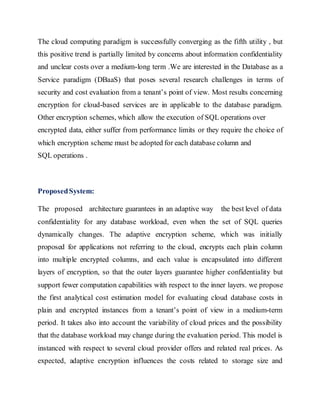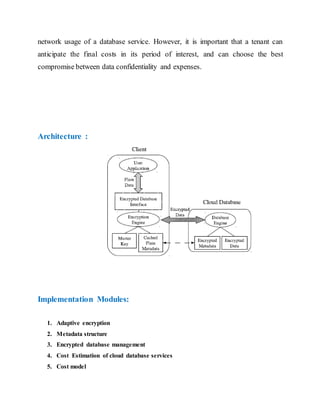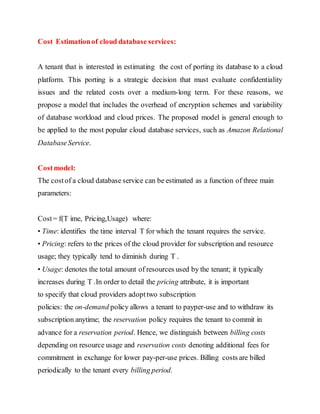IEEE 2014 JAVA CLOUD COMPUTING PROJECTS Performance and cost evaluation of an adaptive encryption architecture for cloud databases
- 1. GLOBALSOFT TECHNOLOGIES Performance and cost evaluation of an adaptive encryption architecture for cloud databases Abstract: The cloud database as a service is a novel paradigm that can support several Internet-based applications, but its adoption requires the solution of information confidentiality problems. We propose a novel architecture for adaptive encryption of public cloud databases that offers an interesting alternative to the trade-off between the required data confidentiality level and the flexibility of the cloud database structures at design time. We demonstrate the feasibility and performance of the proposed solution through a software prototype. Moreover, we propose an original cost model that is oriented to the evaluation of cloud database services in plain and encrypted instances and that takes into account the variability of cloud prices and tenant workload during a medium-term period. Existing System: IEEE PROJECTS & SOFTWARE DEVELOPMENTS IEEE FINAL YEAR PROJECTS|IEEE ENGINEERING PROJECTS|IEEE STUDENTS PROJECTS|IEEE BULK PROJECTS|BE/BTECH/ME/MTECH/MS/MCA PROJECTS|CSE/IT/ECE/EEE PROJECTS CELL: +91 98495 39085, +91 99662 35788, +91 98495 57908, +91 97014 40401 Visit: www.finalyearprojects.org Mail to:ieeefinalsemprojects@gmail.com
- 2. The cloud computing paradigm is successfully converging as the fifth utility , but this positive trend is partially limited by concerns about information confidentiality and unclear costs over a medium-long term .We are interested in the Database as a Service paradigm (DBaaS) that poses several research challenges in terms of security and cost evaluation from a tenant’s point of view. Most results concerning encryption for cloud-based services are in applicable to the database paradigm. Other encryption schemes, which allow the execution of SQL operations over encrypted data, either suffer from performance limits or they require the choice of which encryption scheme must be adopted for each database column and SQL operations . Proposed System: The proposed architecture guarantees in an adaptive way the best level of data confidentiality for any database workload, even when the set of SQL queries dynamically changes. The adaptive encryption scheme, which was initially proposed for applications not referring to the cloud, encrypts each plain column into multiple encrypted columns, and each value is encapsulated into different layers of encryption, so that the outer layers guarantee higher confidentiality but support fewer computation capabilities with respect to the inner layers. we propose the first analytical cost estimation model for evaluating cloud database costs in plain and encrypted instances from a tenant’s point of view in a medium-term period. It takes also into account the variability of cloud prices and the possibility that the database workload may change during the evaluation period. This model is instanced with respect to several cloud provider offers and related real prices. As expected, adaptive encryption influences the costs related to storage size and
- 3. network usage of a database service. However, it is important that a tenant can anticipate the final costs in its period of interest, and can choose the best compromise between data confidentiality and expenses. Architecture : Implementation Modules: 1. Adaptive encryption 2. Metadata structure 3. Encrypted database management 4. Cost Estimation of cloud database services 5. Cost model
- 4. 6. Cloud pricing models 7. Usage Estimation Adaptive encryption: The proposed system supports adaptive encryption methods for public cloud database service, where distributed and concurrent clients can issue direct SQL operations. By avoiding an architecture based on one [or] multiple intermediate servers between the clients and the cloud database, the proposed solution guarantees the same level of scalability and availability of the cloud service. Figure 1 shows a scheme of the proposed architecture where each client executes an encryption engine that manages encryption operations. This software module is accessed by external user applications through the encrypted database interface. The proposed architecture manages five types of information. • plain data is the tenant information; • encrypted data is stored in the cloud database; • plain metadata represent the additional information that is necessary to execute SQL operations on encrypted data; • encrypted metadata is the encrypted version of the metadata that are stored in the cloud database; • master key is the encryption key of the encrypted metadata that is distributed to legitimate clients. Metadata structure:
- 5. Metadata include all information that allows a legitimate client knowing the master key to execute SQL operations over an encrypted database. They are organized and stored at a table-level granularity to reduce communication overhead for retrieval, and to improve management of concurrent SQL operations. We define all metadata information associated to a table as table metadata. Let us describe the structure of a table metadata .Table metadata includes the correspondence between the plain table name and the encrypted table name because each encrypted table name is randomly generated. Moreover, for each column of the original plain table it also includes a column metadata parameter containing the name and the data type of the corresponding plain column (e.g., integer, string, timestamp). Each column metadata is associated to one or more onion metadata, as many as the number of onions related to the column. Encrypted database management: The database administrator generates a master key, and uses it to initialize the architecture metadata. The master key is then distributed to legitimate clients. Each table creation requires the insertion of a new row in the metadata table. For each table creation, the administrator adds a column by specifying the column name, data type and confidentiality parameters. These last are the most important for this paper because they include the set of onions to be associated with the column, the starting layer (denoting the actual layer at creation time) and the field confidentiality of each onion. If the administrator does not specify the confidentiality parameters of a column, then they are automatically chosen by the client with respect to a tenant’s policy. Typically, the default policy assumes that the starting layer of each onion is set to its strongest encryption algorithm.
- 6. Cost Estimation of cloud database services: A tenant that is interested in estimating the cost of porting its database to a cloud platform. This porting is a strategic decision that must evaluate confidentiality issues and the related costs over a medium-long term. For these reasons, we propose a model that includes the overhead of encryption schemes and variability of database workload and cloud prices. The proposed model is general enough to be applied to the most popular cloud database services, such as Amazon Relational Database Service. Cost model: The cost of a cloud database service can be estimated as a function of three main parameters: Cost = f(T ime, Pricing,Usage) where: • Time: identifies the time interval T for which the tenant requires the service. • Pricing: refers to the prices of the cloud provider for subscription and resource usage; they typically tend to diminish during T . • Usage: denotes the total amount of resources used by the tenant; it typically increases during T .In order to detail the pricing attribute, it is important to specify that cloud providers adopt two subscription policies: the on-demand policy allows a tenant to payper-use and to withdraw its subscription anytime; the reservation policy requires the tenant to commit in advance for a reservation period. Hence, we distinguish between billing costs depending on resource usage and reservation costs denoting additional fees for commitment in exchange for lower pay-per-use prices. Billing costs are billed periodically to the tenant every billing period.
- 7. Cloud pricing models: Popular cloud database providers adopt two different billing functions, that we call linear L and tiered T . Let us consider a generic resource x, we define as xb its usage at the b-th billing period and px b its price. If the billing function is tiered, the cloud provider uses different prices for different ranges of resource usage. Let us define Z as the number of tiers, and [ˆx1, . . . , ˆxZ−1] as the set of thresholds that define all the tiers. The uptime and the storage billing functions of Amazon RDS are linear, while the network usage is a tiered billing function. On the other hand, the uptime billing functions of Azure SQL is linear, while the storage and network billing functions are tiered. Usage Estimation: The uptime is easily measurable, it is more difficult to estimate accurately the usage of storage and network , since they depend on the database structure, the workload and the use of encryption. We now propose a methodology for the estimation of storage and network usage due to encryption. For clarity, we define sp, se, sa as the storage usage in the plaintext, encrypted, and adaptively encrypted databases for one billing period. Similarly, np, ne, na represent network usage of the three configurations. We assume that the tenant knows the database structure and the query workload and we assume that each column a A stores ra values. By denoting as vp a the average storage size of each plaintext value stored in column a, we estimate the storage of the plaintext database.
- 8. System Configuration: HARDWARE REQUIREMENTS: Hardware - Pentium Speed - 1.1 GHz RAM - 1GB Hard Disk - 20 GB Floppy Drive - 1.44 MB Key Board - Standard Windows Keyboard Mouse - Two or Three Button Mouse Monitor - SVGA SOFTWARE REQUIREMENTS: Operating System : Windows Technology : Java and J2EE Web Technologies : Html, JavaScript, CSS IDE : My Eclipse Web Server : Tomcat Tool kit : Android Phone Database : My SQL Java Version : J2SDK1.5



![6. Cloud pricing models
7. Usage Estimation
Adaptive encryption:
The proposed system supports adaptive encryption methods for public cloud
database service, where distributed and concurrent clients can issue direct SQL
operations. By avoiding an architecture based on one [or] multiple intermediate
servers between the clients and the cloud database, the proposed solution
guarantees the same level of scalability and availability of the cloud service. Figure
1 shows a scheme of the proposed architecture where each client executes an
encryption engine that manages encryption operations. This software module is
accessed by external user applications through the encrypted database interface.
The proposed architecture manages five types of information.
• plain data is the tenant information;
• encrypted data is stored in the cloud database;
• plain metadata represent the additional information that is necessary to execute
SQL operations on encrypted data;
• encrypted metadata is the encrypted version of the metadata that are stored in the
cloud database;
• master key is the encryption key of the encrypted metadata that is distributed to
legitimate clients.
Metadata structure:](https://image.slidesharecdn.com/performanceandcostevaluationofanadaptiveencryptionarchitectureforclouddatabases-140918040237-phpapp02/85/IEEE-2014-JAVA-CLOUD-COMPUTING-PROJECTS-Performance-and-cost-evaluation-of-an-adaptive-encryption-architecture-for-cloud-databases-4-320.jpg)


![Cloud pricing models:
Popular cloud database providers adopt two different billing functions, that we call
linear L and tiered T . Let us consider a generic resource x, we define as xb its
usage at the b-th billing period and px b its price. If the billing function is tiered,
the cloud provider uses different prices for different ranges of resource usage. Let
us define Z as the number of tiers, and [ˆx1, . . . , ˆxZ−1] as the set of thresholds
that define all the tiers. The uptime and the storage billing functions of Amazon
RDS are linear, while the network usage is a tiered billing function. On the other
hand, the uptime billing functions of Azure SQL is linear, while the
storage and network billing functions are tiered.
Usage Estimation:
The uptime is easily measurable, it is more difficult to estimate accurately the
usage of storage and network , since they depend on the database structure, the
workload and the use of encryption. We now propose a methodology for the
estimation of storage and network usage due to encryption. For clarity, we define
sp, se, sa as the storage usage in the plaintext, encrypted, and adaptively encrypted
databases for one billing period. Similarly, np, ne, na represent network usage of
the three configurations. We assume that the tenant knows the database structure
and the query workload and we assume that each column a A stores ra values. By
denoting as vp a the average storage size of each plaintext value stored in column
a, we estimate the storage of the plaintext database.](https://image.slidesharecdn.com/performanceandcostevaluationofanadaptiveencryptionarchitectureforclouddatabases-140918040237-phpapp02/85/IEEE-2014-JAVA-CLOUD-COMPUTING-PROJECTS-Performance-and-cost-evaluation-of-an-adaptive-encryption-architecture-for-cloud-databases-7-320.jpg)

